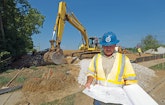
Interested in Cleaning?
Get Cleaning articles, news and videos right in your inbox! Sign up now.
Cleaning + Get AlertsLexington, Ky., is the thoroughbred equestrian capital of the U.S. — possibly the world. The Division of Water Quality of the Lexington-Fayette Urban County Government (LFUCG) is engaged in a race of a different sort, working against time to upgrade its sanitary sewer and stormwater systems.
Having succumbed to age, changing regulations and equipment failures related to deferred maintenance, the system had previously discharged sewage into local streams in violation of the Clean Water Act. A consent degree, finalized in early 2011 by the U.S. Environmental Protection Agency and the Commonwealth of Kentucky, requires Lexington's stormwater and sanitary sewer system to undergo major upgrades within the next 11 to 13 years. The system falls under the responsibilities of the unified county/city government of the LFUCG.
"We started fast and are moving faster," says Charles Martin, director of the LFUCG Division of Water Quality.
Approximately 60 percent of the city's 1,300 miles of sanitary sewer pipeline was built prior to 1964 and is primarily built of vitrified clay. Pipes range from 8 to 72 inches in diameter. Force mains are 18 inches in diameter and are primarily made of ductile iron, with some HDPE construction. The lines are buried between 30 inches and 30 feet deep, depending on topography.
"The transition to PVC started in the 1970s and now everything is PVC except where site conditions require ductile iron," says Martin. "We recently completed the consent decree's requirement for Sewer System Assessments (SSAs) and we've found plenty to keep us busy. Most of the system rates average to poor. Our oldest treatment plant site dates to 1918, so like other cities, older areas have greater degradation issues."
Mapping the Stormwater System
The last effort to map the stormwater system occurred in the 1980s. "When responsibility for the stormwater system was shifted to me in 2007, there was no real map of the current system available," says Martin. "We're positioning ourselves to begin a system-wide assessment, with mapping needing to be done first, similar to what was just completed on the sanitary side."
The division plans to use Esri ArcView GIS mapping software to produce X-Y coordinates for the infrastructure, but will outsource the mapping of infrastructure depth and elevation.
The age of the stormwater system mirrors that of the sanitary sewers, although the lines are generally not buried as deep. The oldest materials are brick, which transitioned into corrugated metal after World War II. Post-1970 construction is largely concrete and PVC, with some ABS and truss pipe.
The division's repair budget for both systems amounts to about $2 million annually, although that budget will rise to $5 million in the next fiscal year. Repair efforts are currently focused on neighborhood sewers that meet certain criteria of age, condition or high R-value results from flow monitoring.
HDPE Problematic
The division's HDPE force mains, which have suffered from longitudinal cracks, are particularly problematic.
"Some of them have failed a dozen times in 10 years, and they're difficult to fix because standard repair clamps don't fit around the pipe," says Martin. "When we replace HDPE with ductile iron, we know we can repair those lines in the future without bringing in outside contractors."
The division uses internal crews to make point repairs to mainlines and service laterals. It contracts out for larger repairs, including dig-and-replace and cured-in-place repair projects on main lines. Mechanical root cutting and chemical root treatment are also outsourced.
"We do not reline pipe internally or complete pipe replacements longer than 10 linear feet because it ties up the crews too much and there is ample contractor supply in the area to outsource these jobs," says Martin.
Manhole Rehabilitation is Currently on Deferral.
"The lining products used in the past didn't seem to perform," notes Martin. "Manhole replacement is the primary method currently used, performed both by internal crews and outside contractors, but we know we're going to have to move back to in-place rehab methods at some point."
Routine sewer maintenance is performed by internal crews with a budget of about $1 million annually. The division fields three Vactor trucks and one basic jet truck.
"The Vactor trucks do the preventive maintenance work while the jet truck does mostly service interruption calls," says Martin.
Scoping the System
Since 2008, the LFUCG has invested over $10 million in system assessments as part of the implementation of the consent decree.
Internal crews perform CCTV inspections with two CUES-equipped inspection trucks operating with the company's Granite XP software. The crews use a push camera to scope service laterals.
"Our crews will start using RedZone Robotics Solo cameras next fiscal year," says Martin. "We had a demonstration last year and liked the product."
The division also conducts its own routine smoke testing using two liquid smoke units by Hurco.
"During the SSA, contractors smoke-tested over 4.9 million linear feet of the system, but I don't anticipate any extensive smoke work over the next couple of years because the earlier work gave us plenty of defects to focus on for now," says Martin. "Further into the master plan, we will do more smoke testing as we complete current repairs and establish the connectivity of the stormwater system."
Capital construction projects have also shifted into high gear. One of the division's significant achievements is the construction of its South Elkhorn pump station and force main, which eliminated Lexington's major contributor to sanitary sewer overflow.
A Remedial Measures Plan (RMP) capital works program, scheduled to begin this fiscal year, is projected to invest more than $550 million in trunk sewer replacements, pump station rehabilitation, wet weather storage and treatment plant reliability improvements.
"We're looking at up to 105 MG of offline storage at up to seven different locations within the system," says Martin. "Construction will be phased and plant site storage will be created in cells so that, as we eliminate I&I, potential capital savings can be achieved by eliminating the need for the final cells."
Program development, which required a significant public expenditure, involved a series of public meetings and community outreach efforts. Martin appeared at public events asking the community exactly what sort of system ratepayers wanted to invest in, pointing out that higher quality costs more money.
Martin explained, for example, that an overhaul of the sewer system in the Wolf Run watershed would require a $40-million investment to protect against the type of flooding caused by a 24-hour storm of the severity that might occur every two years, but $65 million for a 10-year storm.
"Generally, ratepayers tell us to give them the cheapest system possible, even though that choice may not give them the system they want," says Martin, "They're very concerned about escalation of their rates."
Acquiring Easements
One of the biggest challenges in completing the RMP involves easement and right-of-way acquisition, since much of the infrastructure is now located in rear and side yard easements in established neighborhoods. "That makes for tough construction in what is often a politically charged environment," says Martin. "Landowners aren't always cooperative."
The massive construction projects may also challenge the limits of local contractor capacity. "Once the RMP projects start, we'll be doing between 10 and 15 projects a year — considerably more than the current market is used to," says Martin. "We're often competing with larger, nearby markets, including Cincinnati and Louisville, that are also operating under consent decrees with aggressive construction schedules."
While the division is set to undertake the most ambitious construction and rehabilitation program it has ever overseen, the region faces continued economic pressure and staffing levels remain static.
"However, our motto here is, 'begin with the end in mind,' " says Martin. "Working toward our ultimate goals keeps us on task for the things we need to do."










